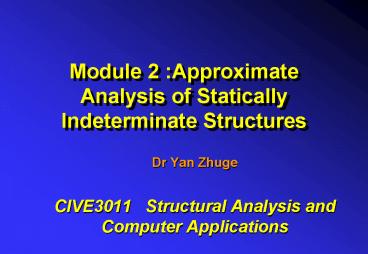Module 2 :Approximate Analysis of Statically Indeterminate Structures - PowerPoint PPT Presentation
1 / 24
Title:
Module 2 :Approximate Analysis of Statically Indeterminate Structures
Description:
Portals can be pin supported, fixed supported or supported by partial fixity ... Partial fixity. fixed -supported. Pin-supported. approximation. real structure ... – PowerPoint PPT presentation
Number of Views:1291
Avg rating:3.0/5.0
Title: Module 2 :Approximate Analysis of Statically Indeterminate Structures
1
Module 2 Approximate Analysis of Statically
Indeterminate Structures
- Dr Yan Zhuge
- CIVE3011 Structural Analysis and Computer
Applications
2
Introduction
- Using approximate methods to analyse statically
indeterminate trusses and frames - The methods are based on the way the structure
deforms under the load - Trusses
- Portal frames with trusses
- Vertical loads on building frames
- Lateral loads on building frames
- Portal method
- Cantilever method
3
Approximate Analysis
- Statically determinate structure the force
equilibrium equation is sufficient to find the
support reactions - Approximate analysis to develop a simple model
of the structure which is statically determinate
to solve a statically indeterminate problem - The method is based on the way the structure
deforms under loads - Their accuracy in most cases compares favourably
with more exact methods of analysis (the
statically indeterminate analysis)
4
Determinacy - truss
Statically determinate
Statically indeterminate
b total number of bars r total number of
external support reactions j total number of
joints
5
Trusses
b16, r3, j8
br 19 gt 2j16
The truss is statically indeterminate to the
third degree
Three assumptions regarding the bar forces will
be required
6
Example 1 - trusses
Determine (approximately) the forces in the
members. The diagonals are to be designed to
support both tensile and compressive forces.
FFB FAE F
FDB FEC F
7
Portal frames lateral loads
- Portal frames are frequently used over the
entrance of a bridge - Portals can be pin supported, fixed supported or
supported by partial fixity
8
Portal frames lateral loads
A point of inflection is located approximately at
the girders midpoint
assumed hinge
One assumption must be made
Points of inflection are located approximately at
the midpoints of all three members
assumed hinge
Three assumption must be made
Points of inflection for columns are located
approximately at h/3 and the centre of the girder
assumed hinge
9
Pin-Supported Portal Frames
- A point of inflection where the moment changes
from positive bending to negative bending. - Bending moment is zero at this point.
The horizontal reactions (shear) at the base of
each column are equal
10
Fixed-Supported Portal Frames
- A point of inflection where the moment changes
from positive bending to negative bending. - Bending moment is zero at this point.
The horizontal reactions (shear) at the base of
each column are equal
11
Frames with trusses
- When a portal is used to span large distance, a
truss may be used in place of the horizontal
girder - The suspended truss is assumed to be pin
connected at its points of attachment to the
columns - Use the same assumptions as those used for simple
portal frames
12
Frames with trusses
13
Example 2 Frame with trusses
Determine by approximate methods the forces
acting in the members of the Warren portal.
14
Example 2 (contd)
15
Building frames vertical loads
- Building frames often consist of girders that are
rigidly connected to columns - The girder is statically indeterminate to the
third degree require 3 assumptions
Average point between the two extremes
(0.21L0)/2 0.1L
If the columns are extremely stiff
If the columns are extremely flexible
16
Building frames vertical loads
17
Example 3 Vertical loads
Determine (approximately) the moment at the
joints E and C caused by members EF and CD.
18
Building frames lateral loads Portal method
- A building bent deflects in the same way as a
portal frame - The assumptions would be the same as those used
for portal frames - The interior columns would represent the effect
of two portal columns
19
Building frames lateral loads Portal method
20
Example 4 Portal method
Determine (approximately) the reactions at the
base of the columns of the frame.
21
Building frames lateral loads Cantilever method
- The method is based on the same action as a long
cantilevered beam subjected to a transverse load - It is reasonable to assume the axial stress has a
linear variation from the centroid of the column
areas
22
Building frames lateral loads Cantilever method
23
Example 5 Cantilever method
Show how to determine (approximately) the
reactions at the base of the columns of the
frame.
24
Example 5 Cantilever method































